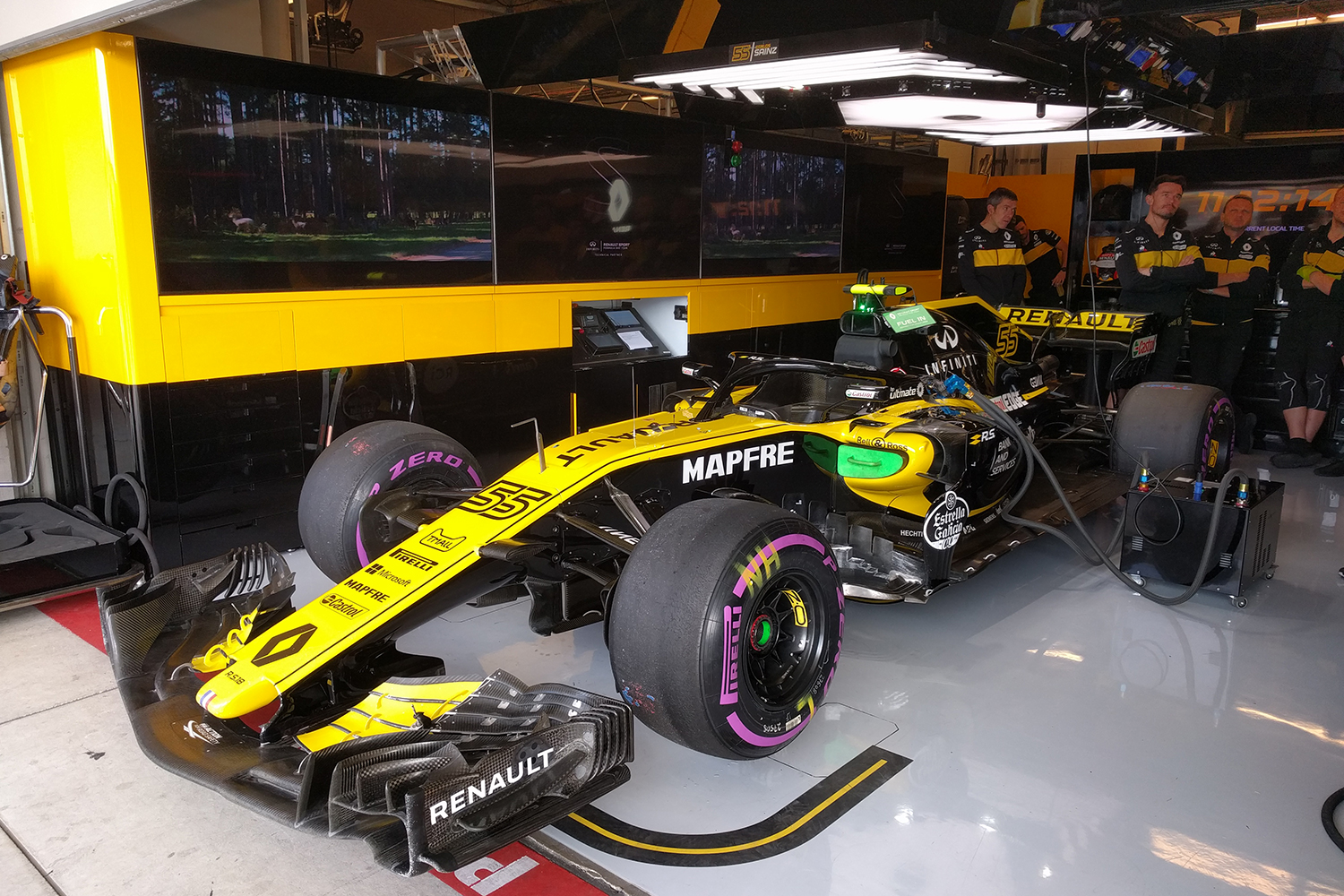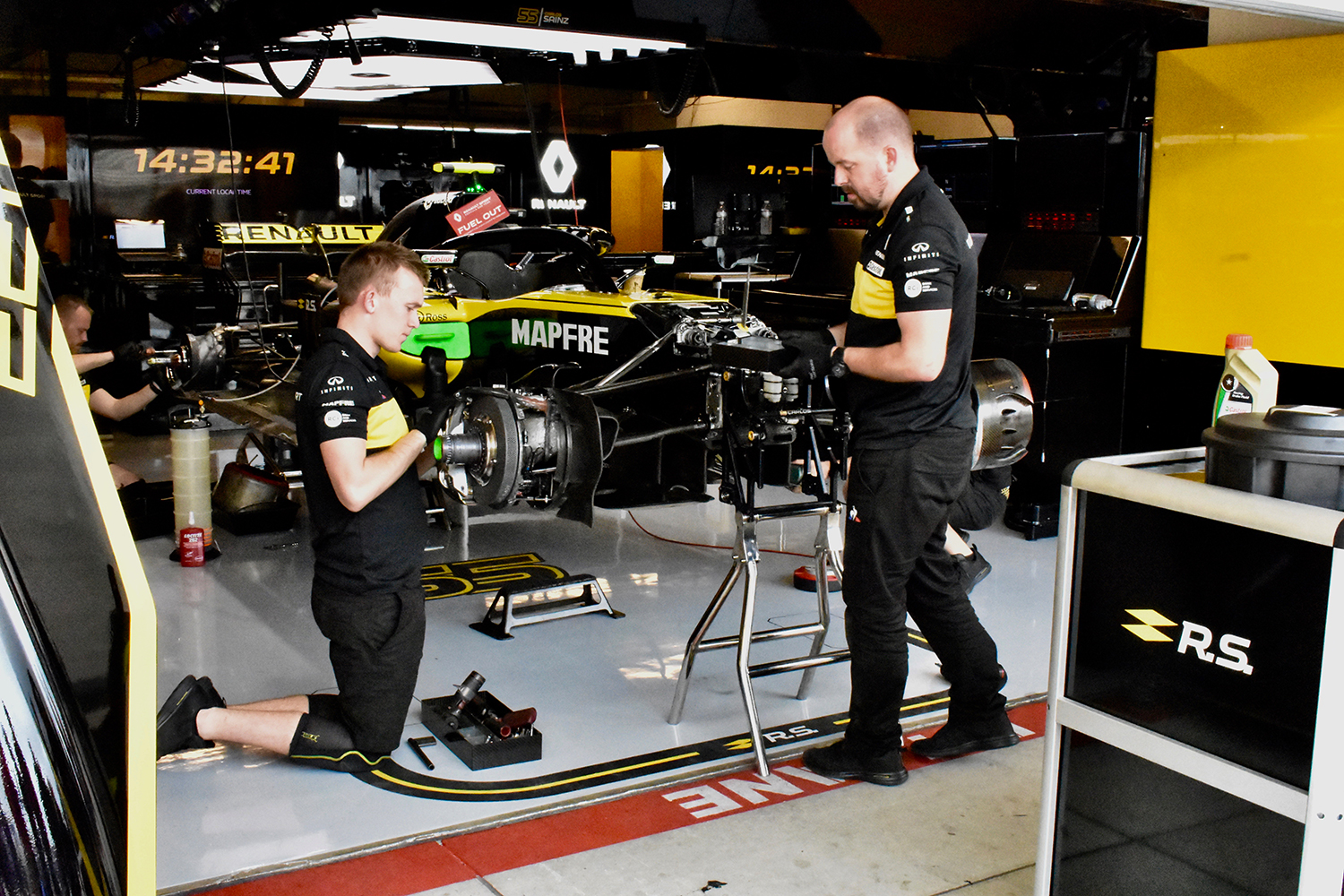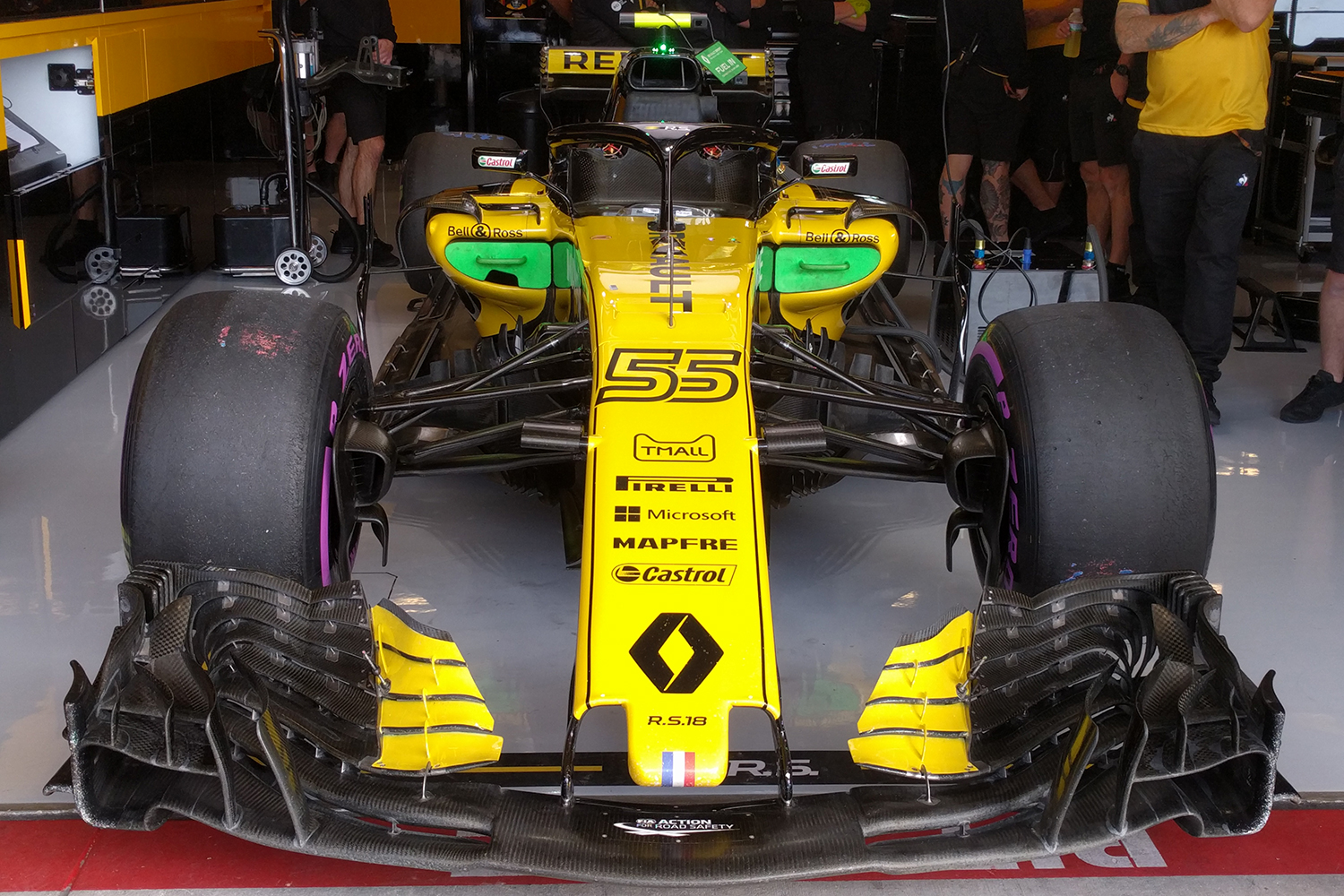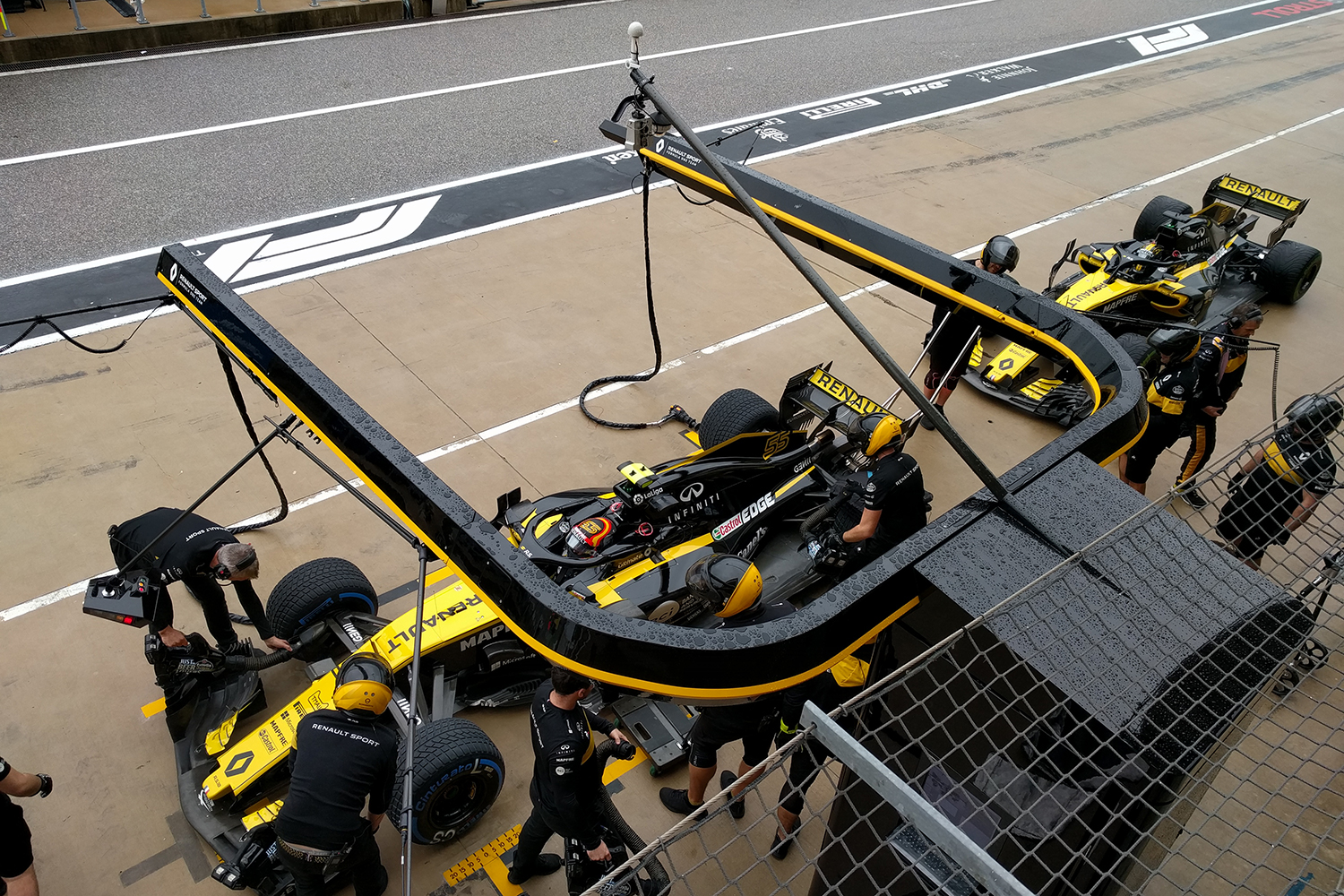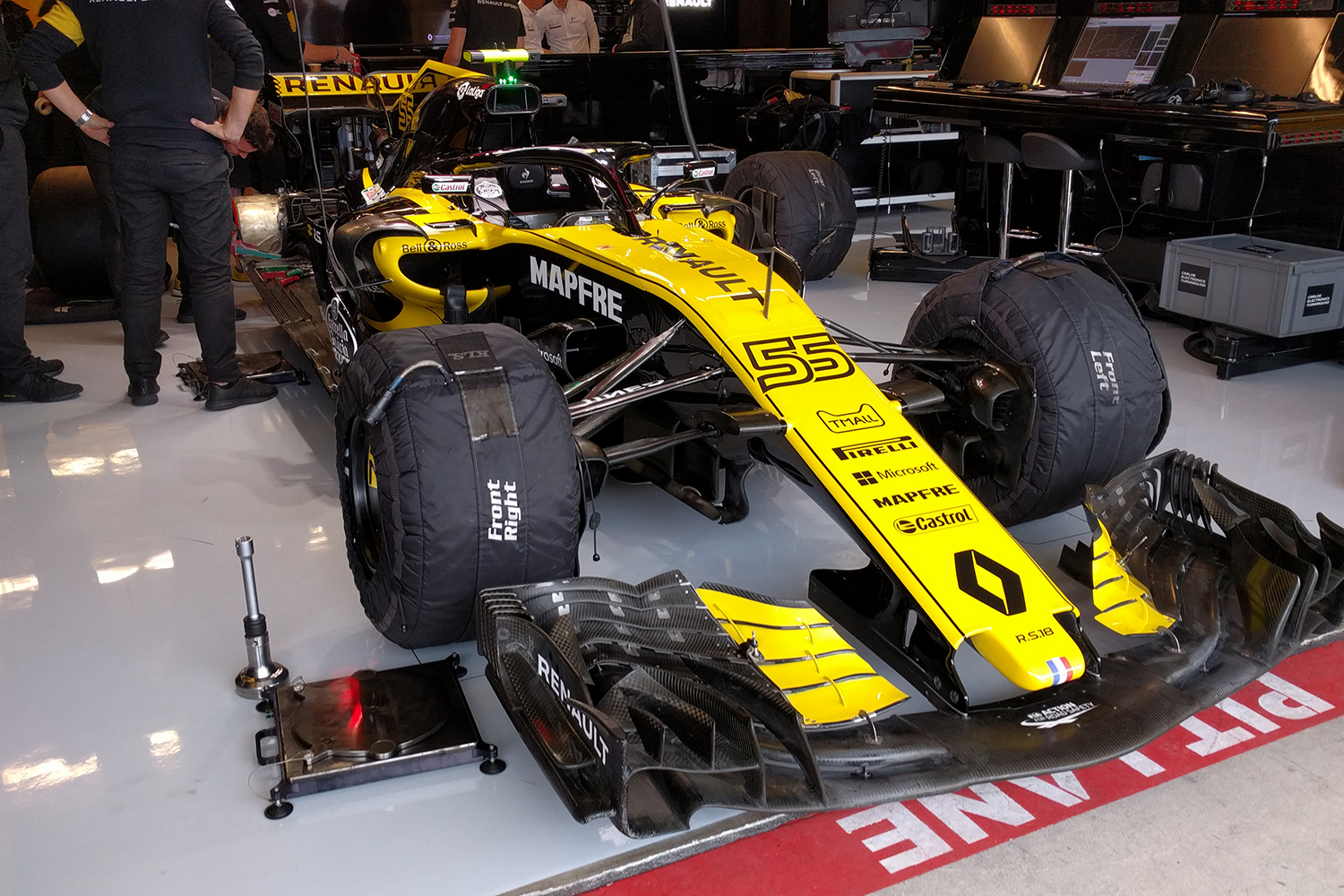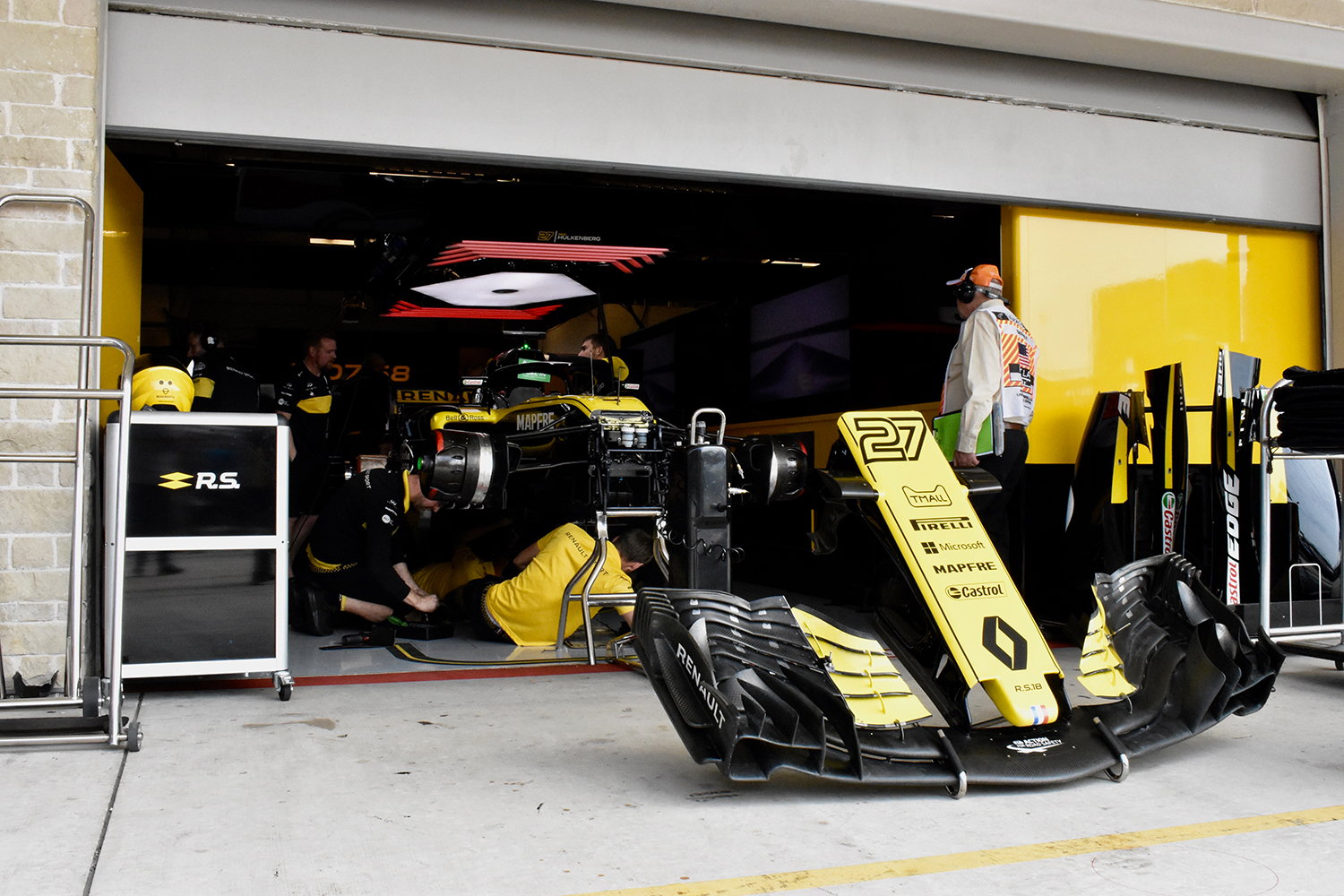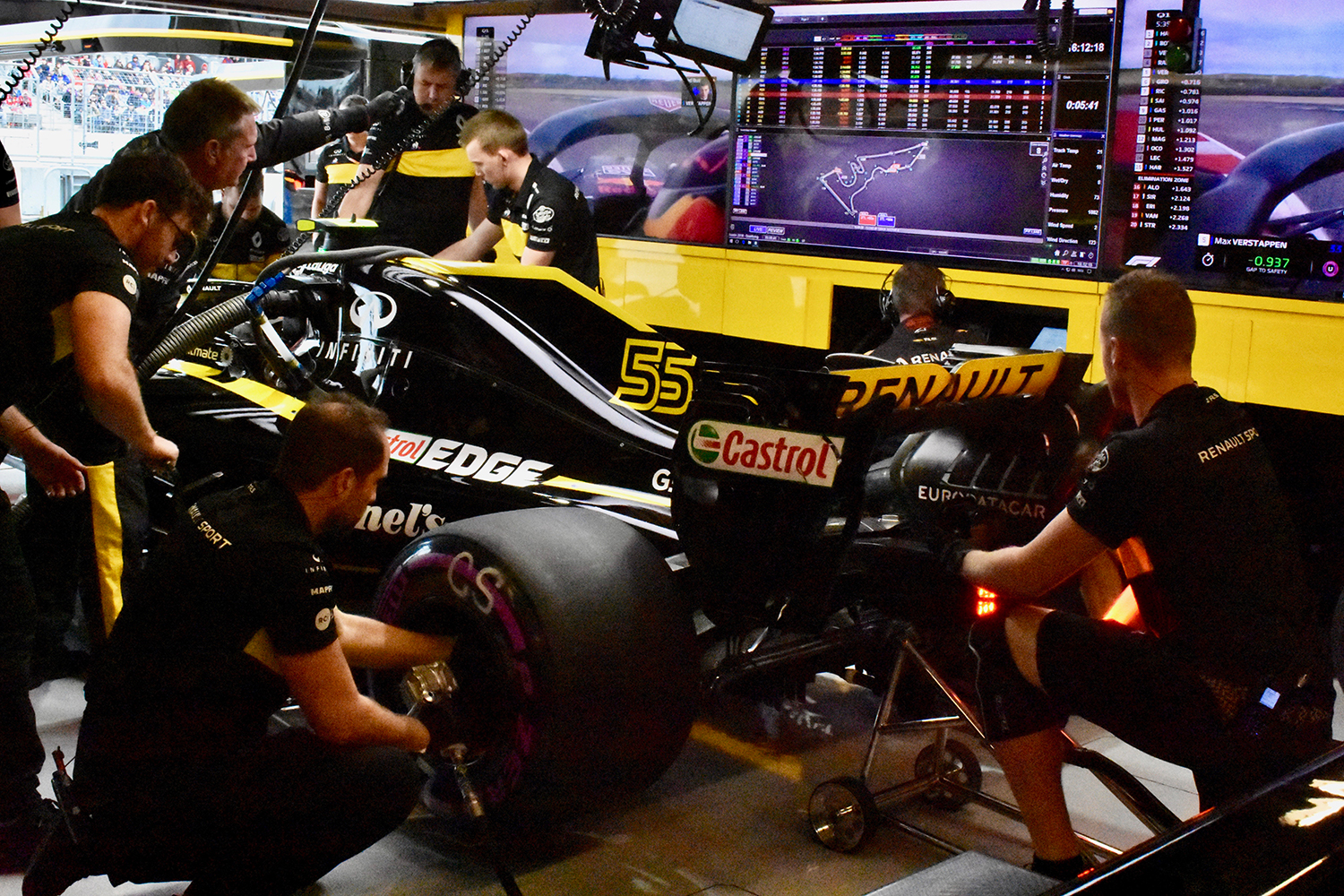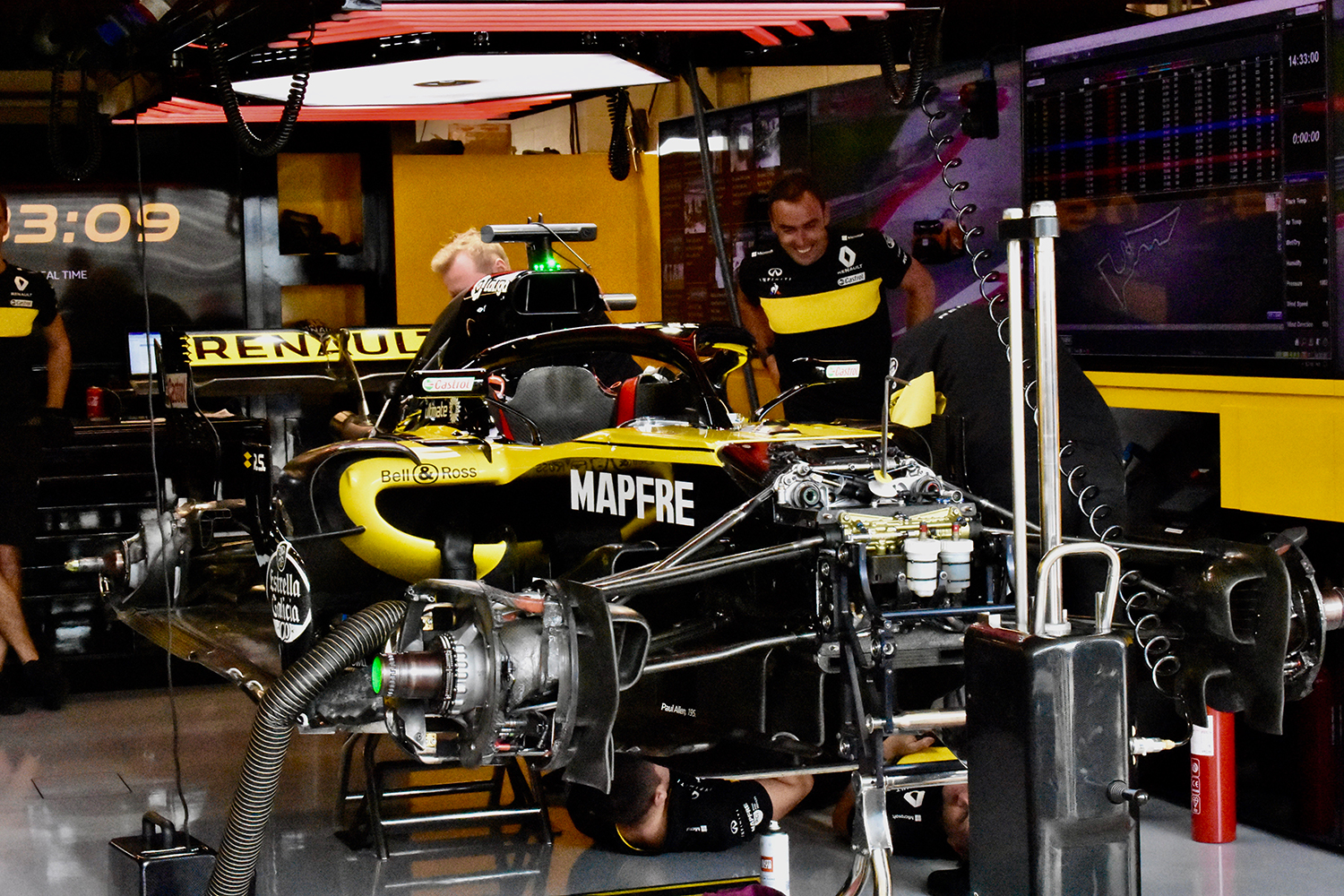A modern Formula One car almost looks like no one is driving. The driver sits hunkered down behind crash-protection structures, with just the tip of the helmet visible. But at least drivers keep a high profile when they get out of the cars; the legions of engineers and mechanics that build and maintain F1 cars almost never see the limelight. It’s easy to forget that human beings make technology—and all of the amazing things it does—possible.
But it’s the human element that Infiniti believes is key to advancing both road cars and F1 race cars. Infiniti is partnering with the Renault Sport Formula One team in order to orchestrate a transfer of technology. But instead of sharing exhaust manifolds or computer chips, Infiniti and Renault are sharing people—engineers—in order to make cars better both on and off the track.
“Win on Sunday, sell on Monday”
One of the oldest maxims in the auto industry is “win on Sunday, sell on Monday.” It’s the belief that success on the track will translate into success in the showroom. The connection between road cars and race cars is something valued not just by automakers, but by enthusiasts who want to capture some reflected motorsports glory in cars they can actually buy. But other than having four wheels, Formula One cars and road cars have virtually nothing in common. So, is the connection really such a big deal?
The link is typically exploited in two main ways. One is marketing: like any other sport, F1 has a powerful allure to the buying public. F1 is also by far the most glamorous form of motorsport, and it has a global reach. Racing is particularly important to a luxury brand like Infiniti, because performance is such a big part of the image of cars in that segment. Infiniti doesn’t have much of a racing pedigree, but competitors like Audi, BMW, Mercedes-Benz, and Jaguar do.
Racing can be a proving ground for technologies that may eventually find their way into road cars.
On the more substantive side, racing can be a proving ground for technologies that may eventually find their way into road cars. Everything from the rear-view mirror to carbon-fiber construction was tried out on the track before making it to the road. Turbochargers are a common performance booster in today’s road cars in part because Renault proved their efficacy in Formula One beginning in the 1970s. The need to win encourages racing engineers to try out more radical ideas, and the extreme punishment components are subjected to on the track makes racing an excellent test of durability.
Efforts have also been made recently to draw Formula One cars and road cars closer together. Since 2014, all F1 cars have used hybrid powertrains. The move was made in part to increase relevance to road cars. Automakers are being cajoled by tightening global emissions standards into building more hybrid and all-electric cars. Infiniti plans to introduce only hybrid and all-electric models beginning in 2021.

“The experience we are getting in Formula One, where the hybrid technology is pushed to the extremes of performance and reliability, is invaluable for us,” said Tommaso Volpe, Infiniti’s global director of motorsport.
An engineering alliance
The partnership between Infiniti and the Renault Sport Formula One team came about primarily because both entities are under the same corporate roof. Infiniti is the luxury brand of Nissan, which is joined with Renault (and Mitsubishi) in a corporate alliance. Renault has a long history in F1, both as a team and as an engine supplier to other teams.

Infiniti first became involved in Formula One as a sponsor of Red Bull Racing, which uses Renault engines. The team won four world championships between 2010 and 2013 with driver Sebastian Vettel. That success reflected well on Infiniti, but the relationship was purely about marketing. The only products were chintzy gestures like naming Vettel as Infiniti’s “director of performance” and selling a special edition of the FX SUV with his name on it.
Infiniti and Renault wanted the luxury brand’s involvement in F1 to be substantive.
Red Bull and Renault eventually had a falling out (Red Bull still uses Renault engines, but will switch to Honda for 2019), and Renault decided to get back into F1 with a team of its own. This time around, both Infiniti and Renault wanted the luxury brand’s involvement in F1 to be more substantive.
“It’s not about sponsorship, it’s not about just putting a sticker on the car, it’s not just about coming to the grand prix and using the hospitality of the grand prix as an incentive. It’s really about sharing engineers, sharing R&D,” Volpe said of the new partnership.
By the time Formula One went hybrid in 2014, Infiniti had been selling hybrids for three years. The luxury brand had developed a hybrid powertrain for its Q50 and Q70 sedans (the hybrids were recently withdrawn from the U.S.). Its engineers were tasked with helping develop the hybrid system for Renault’s F1 cars. Racing is supposed to represent the cutting edge of automotive technology, but this time it was the road-car engineers teaching the race team some new tricks.

“When Infiniti came with its strategy of electrification, everything around electrification, we said obviously we have something to do in common,” said Jerome Stoll. As president of Renault Sport Racing, Stoll is in charge of all of the French automaker’s racing activities—including F1. Stoll was one of the driving forces behind Renault’s return to F1 as a full-fledged team, and he said he was motivated by the promise of adapting racing technology to the road. The race team partnered with Infiniti rather than Renault’s own road-car division because of the cost of that technology, he said.
“When you want to install such very expensive technology, obviously the first step is to put it in a car that belongs to the premium segment of the car industry,” Stoll said. “Renault does not have in its lineup, for the time being, such a car that will be sold at a price which will accommodate the technology.” He added that eventually it might be possible to “decrease the cost of this technology and adapt it to a lineup which is more affordable for the general public.”
It’s all about people
Cost isn’t the only issue. You can’t simply take parts off a Formula One car and bolt them onto an everyday car, or vice versa. An F1 hybrid system is very different from that of the average Toyota Prius. But Infiniti and Renault believe the same people can work on both, transmitting knowledge in the process.

“Even if the products are totally different, and of course in the regulations the way the products are built are totally different, the engineering theories and approach are very similar,” Volpe, the Infiniti motor-sport boss, said. Renault Sport Racing boss Stoll echoed his comments.
“Formula One, maybe you feel it’s very much structured, but it’s ideas coming from everywhere. You have to improve step by step with very small details. So any ideas that may come from one partner or another can be used together.”
Infiniti has tried to drive this point home with the Infiniti Engineering Academy (IEA). Every year, engineering students apply for a chance to win a year-long placement, split between the Renault Sport F1 team’s headquarters in Enstone, England, and a U.K. Infiniti technical facility. Past winners have gone on to jobs within the Renault-Nissan-Mitsubishi Alliance, as well as at other companies like Dyson – which is developing an electric car of its own – and SpaceX.

Out of thousands of applications, seven winners are chosen—each from a different major global region. The winner for each region is selected through a series of challenges that emphasize everything from basic problem solving to secondary skills like public relations. For the three 2018 U.S. finalists, that involved getting grilled by Digital Trends and other media in a mock press conference. Winners get a rare opportunity to polish their skills at both an F1 team and a major automaker, while Infiniti and Renault get to cultivate the next generation of gearhead talent.
“I’ve been surrounded by cars my whole life, and I wanted to purse engineering as a way to continue that involvement,” said Evan Sloan, the 2017 IEA U.S. winner. The 2018 winner, Sabre Cook, is not only an engineering student but also an amateur racer, competing in Formula Four.
An unclear road ahead
It’s nice to know that the engineers who worked on your luxury sedan were good enough to work on Formula One cars, but is brainpower really the only thing being shared by Infiniti and Renault?
At the 2018 Paris Motor Show, Infiniti unveiled the Project Black S, a modified production car incorporating an F1-style hybrid system. Engineers took a Q60 coupe and added a rear-mounted electric motor, which works with the stock 3.0-liter, twin-turbocharged V6 to produce 563 horsepower. While none of the specific components are the same, the hybrid system is more or less identical to that of an F1 car. A “motor generator unit-kinetic (MGU-K)” harvests energy from braking, and a “motor generator unit-heat (MGU-H)” system uses the turbochargers to generate electricity.
Infiniti expects the Black S to do zero to 60 mph in less than 4.0 seconds, compared to 4.8 seconds for the stock Q60. The Black S is a clear demonstration of how F1 tech can be applied to road cars, but Infiniti hasn’t decided whether to put it into production.
The Black S demonstrates how F1 tech can be applied to road cars, but Infiniti hasn’t decided on production.
“We are looking forward to seeing this car on the track, and then hopefully can decide if we go into production,” Infiniti president Roland Krueger said. “I’m raising my hand first, because I want to have this car.” In general, he said Infiniti will try to emphasize the performance possibilities of hybrids, and that the Black S was built to show how electrification can improve performance.
“I think one of the things we tend to underestimate is the opportunity of the driving experience that electrification can give you. You have instant torque, instant acceleration,” Krueger said. But Infiniti isn’t the only automaker trying to make that point. The “Holy Trinity” of supercars—the Ferrari LaFerrari, McLaren P1, and Porsche 918 Spyder—made a compelling argument for hybrid performance. Acura did most of the development work on its NSX hybrid supercar while parent Honda was on an F1 hiatus. Volvo, which has never competed in F1, is building its Polestar performance brand entirely around electrified powertrains. Meanwhile, Infiniti doesn’t even sell any hybrids or electric cars in the U.S. at the moment.
Infiniti will launch more electrified models in the coming years as it works to meet its 2021 goal, but it’s unclear how much F1 DNA they will have. Mercedes is trying to adapt an F1 powertrain to its AMG Project One, but that car is an exotic with a production run of just 275 units, and an estimated price tag of $2.7 million. Making the same technology work on mass-market models will be difficult.
“When you move an F1 technology to a car on the road, you have to consider the constraints, which are completely different,” Stoll said. “An engine for F1 lasts 7,000 kilometers [4,350 miles]. Somebody who buys a car doesn’t expect it to break after 7,000 km.” Race cars and road cars must also comply with completely different regulations, and F1 changes its rules every few years. The current hybrid formula is fairly relevant to automakers like Infiniti, but what happens when the rules change? What if automakers embrace all-electric cars and leave F1 behind for the likes of Formula E?
“I strongly believe that this race is not a dinosaur, will not become a dinosaur,” Stoll said. “It will remain for another decade, definitely, maybe more. The excitement around these powerful cars cannot be offered by any other product.”
The racetrack and the road are two differently worlds, but Infiniti has shown that its engineers can walk between them. But it remains to be seen whether Infiniti can use that connection to preserve both the environment and the excitement of driving.
Editors' Recommendations
- Virtual Formula One racing needs to embrace chaos to succeed
- Porsche will use discarded F1 tech for a new hybrid supercar, report claims
- Infiniti bets its future on a hybrid system that has flummoxed other automakers
- Ready for Prius on Prius racing? NASCAR could go hybrid in 2022
- Ferdinand Porsche was 100 years ahead of his time with his 1900 hybrid
